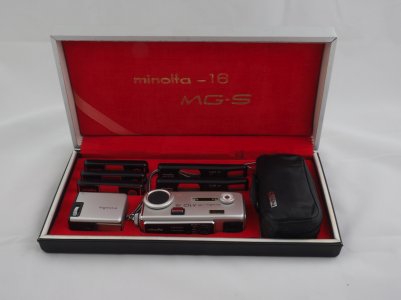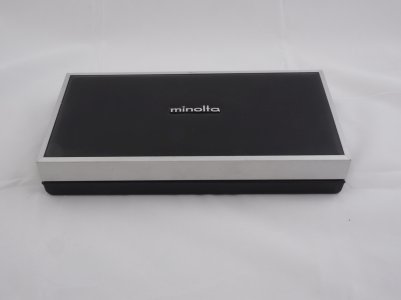Bill Watts
Well-Known Member
This is a Minolta-16 MG-S, the penultimate 16mm still camera Minolta made, the last one being the Minolta-16 QT, a simplified and cheaper version of the MG-S. The MG-S was probably the most sophisticated version of the whole Minolta-16 range of subminiature cameras and was available in chrome and black versions.
It featured a fixed-focus, Rokkor f2.8/23mm lens with 4 elements in 3 groups, an additional close-up element mounted on a sliding mechanism which allowed it to be placed in front of the lens, apertures, set manually between f2.8 and f16, or fully automatically, controlled by a CdS meter close to the lens (EV 8–17) and shutter speeds set manually between 1/30 and 1/500 sec with X sync at all speeds. The aperture priority, match needle automation had a range of 25 to 400 ISO.
The frame size of the negative was increased from the previous models 10 x 14mm to 12 x 17mm, similar to that of 110 frames, but it used a proprietary cassette which was user reloadable, but not interchangeable with any other 16mm film camera made at the time. All the manufacturers had different cassettes. (Fujica, Ricoh, Mamiya, Kiev, and Yashica to name just a few)
The camera was designed as a system camera and had a large range of accessories. It was available to purchase on it's own with a case, with a cube or flash adapter, as a "small system kit" with flash adapter, measuring chain, filters and close up lenses (all with individual plastic cases) in a presentation case and as a "system kit" in an attache case with all of the accessories.
In 1971 the small system kit shown below sold for about £98, equivalent to approximately £1,420 in 2024! The camera and case retailed for about £72 - £1044 in 2024!

Minolta-16 MG-S Small System Kit

Minolta-16 MG-S Small System Kit presentation case.
Photography has never been a cheap hobby!
An example photograph from the MG-S

Photo taken in Indonesia on Fuji superia 200 film.
In 1972 Kodak introduced the 110 format film and camera, and due to the popularity of the interchangeable format, and it's reasonable pricing (Although there were some expensive 110 cameras) it killed off the 16mm film cameras almost overnight.
Bear in mind the £1,044 buys a pretty good camera in 2024, however it comes in a classy cardboard box if you are lucky. In some ways times have changed, and in others they are still the same!
It featured a fixed-focus, Rokkor f2.8/23mm lens with 4 elements in 3 groups, an additional close-up element mounted on a sliding mechanism which allowed it to be placed in front of the lens, apertures, set manually between f2.8 and f16, or fully automatically, controlled by a CdS meter close to the lens (EV 8–17) and shutter speeds set manually between 1/30 and 1/500 sec with X sync at all speeds. The aperture priority, match needle automation had a range of 25 to 400 ISO.
The frame size of the negative was increased from the previous models 10 x 14mm to 12 x 17mm, similar to that of 110 frames, but it used a proprietary cassette which was user reloadable, but not interchangeable with any other 16mm film camera made at the time. All the manufacturers had different cassettes. (Fujica, Ricoh, Mamiya, Kiev, and Yashica to name just a few)
The camera was designed as a system camera and had a large range of accessories. It was available to purchase on it's own with a case, with a cube or flash adapter, as a "small system kit" with flash adapter, measuring chain, filters and close up lenses (all with individual plastic cases) in a presentation case and as a "system kit" in an attache case with all of the accessories.
In 1971 the small system kit shown below sold for about £98, equivalent to approximately £1,420 in 2024! The camera and case retailed for about £72 - £1044 in 2024!

Minolta-16 MG-S Small System Kit

Minolta-16 MG-S Small System Kit presentation case.
Photography has never been a cheap hobby!
An example photograph from the MG-S

Photo taken in Indonesia on Fuji superia 200 film.
In 1972 Kodak introduced the 110 format film and camera, and due to the popularity of the interchangeable format, and it's reasonable pricing (Although there were some expensive 110 cameras) it killed off the 16mm film cameras almost overnight.
Bear in mind the £1,044 buys a pretty good camera in 2024, however it comes in a classy cardboard box if you are lucky. In some ways times have changed, and in others they are still the same!
